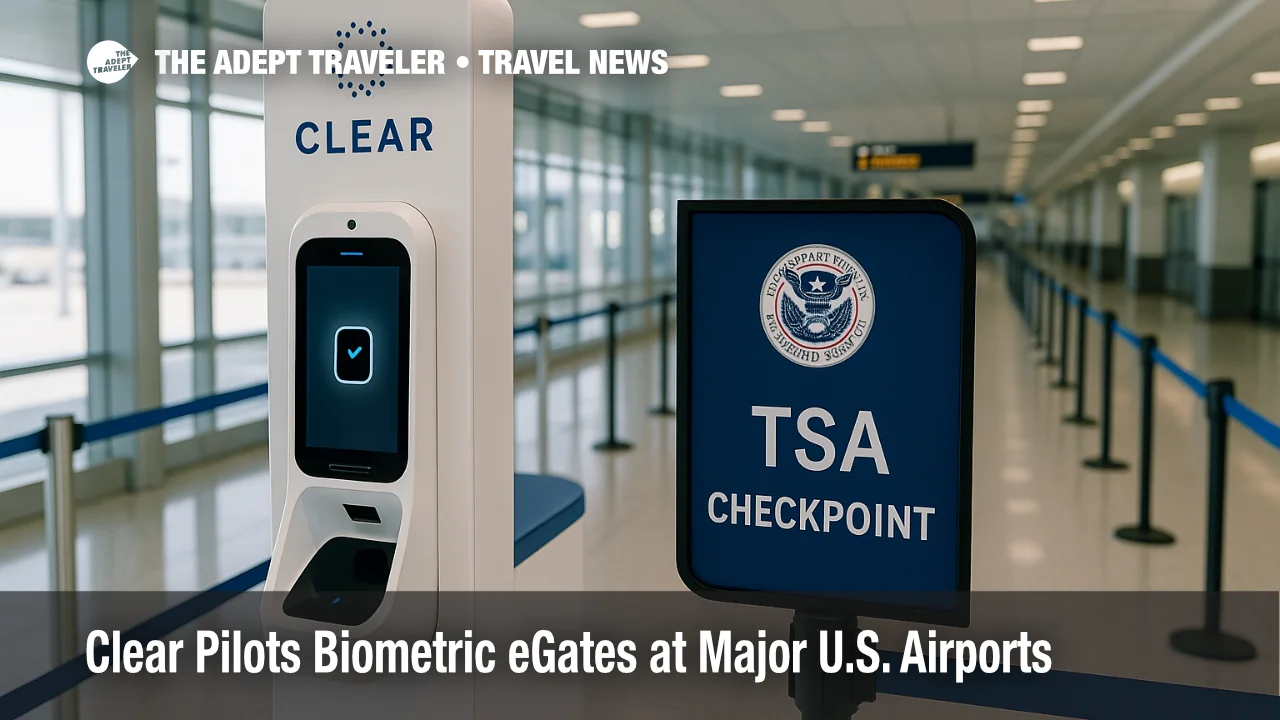Clear Pilots Biometric eGates at Major U.S. Airports

Clear has launched its first biometric eGate at Hartsfield-Jackson Atlanta International Airport (ATL), a pilot with the Transportation Security Administration that lets members verify identity and proceed straight to physical screening. Clear says similar eGates will be activated at Ronald Reagan Washington National Airport (DCA) and Seattle-Tacoma International Airport (SEA) in the coming weeks, part of a broader push to automate the checkpoint experience ahead of 2026's travel surge. TSA retains operational control of the gates and screening.
Key Points
- Why it matters: Biometric eGates remove the TSA podium stop for faster throughput.
- Travel impact: Clear members should see shorter, steadier wait times at checkpoints.
- What's next: DCA and SEA follow Atlanta, with wider expansion planned.
- Competition: TSA's PreCheck Touchless ID is active at 14 U.S. airports.
- Tech shift: Clear's face-first EnVe pods replaced older iris and fingerprint checks.
Snapshot
The eGate verifies a traveler's face against their ID and boarding pass, then opens to route them directly into TSA screening. This removes the separate ID check at the TSA podium and reduces escort bottlenecks that sometimes slowed Clear lanes. Clear frames the pilot as a public, private collaboration designed to scale identity verification ahead of the FIFA World Cup and America's 250th anniversary, both expected to strain U.S. checkpoints. In parallel, TSA's PreCheck Touchless ID program is expanding at select hubs with major airlines, making hands-free identity checks more common even outside Clear lanes. For travelers, this competition should translate to faster lines, but it also brings renewed scrutiny of privacy practices.
Background
Clear built its service around biometrics to speed document control at airports. In late 2024, the company rolled out EnVe pods, a face-first system it says is five times faster than older iris and fingerprint scans, and spent early 2025 converting its network. TSA, for its part, has been piloting and scaling facial comparison for identity checks, including PreCheck Touchless ID with American, Delta, United, and Alaska at a growing list of airports. That program, which relies on a passport image shared through the airline, is now active at about 14 airports. For context on TSA's rollout and Denver's recent activation, see Denver Adds TSA PreCheck Touchless ID Lanes.
Latest Developments
Biometric eGates begin at ATL, then DCA and SEA
On August 19, 2025, Clear opened the first eGate at Hartsfield-Jackson Atlanta International Airport (ATL). The pilot allows members to scan a boarding pass, complete a facial match, and immediately enter the screening lanes, while TSA officers maintain full authority over gate logic and security procedures. Clear and TSA say the design is intended to scale quickly, with Ronald Reagan Washington National Airport (DCA) and Seattle-Tacoma International Airport (SEA) slated next. Local officials in Atlanta described the test as a step toward easing peak-hour congestion, and Clear indicates the rollout will prioritize host cities and other high-volume hubs as it prepares for major events in 2026.
Analysis
Clear's eGates target the choke point that most frustrates frequent flyers, the handoff from Clear verification to the TSA podium. By eliminating that stop, the system should produce steadier flow and fewer escorts, especially where Clear lanes back up during morning bank times. The competitive backdrop is pivotal. TSA's PreCheck Touchless ID offers similar facial-match convenience within the government lane, reducing Clear's exclusivity to lane real estate, staffing, and its ability to iterate hardware quickly. Clear's advantage is speed to market and a willingness to invest, at no taxpayer cost, to modernize checkpoints. TSA's advantage is ubiquity and airline integration.
Privacy and policy will shape the pace. A pending Senate proposal would pause new TSA facial-recognition units, potentially slowing Touchless ID growth and shifting demand back toward private solutions, or delaying automation altogether. For more on that debate, see TSA Biometric-Ban Bill Could Jam Holiday Checkpoints. In the near term, travelers should expect more biometric lanes, clearer signage, and small but meaningful time savings that, multiplied across peak periods, can reduce missed flights and staffing strain.
Final Thoughts
Clear's pilot marks a logical next step in automating airport identity checks, and it lands as TSA accelerates its own touchless verification. If the agencies and Clear continue to coordinate lane design, staffing, and signage, travelers will gain faster, more predictable experiences with clearer opt-in choices. The decisive factors will be reliability at scale, transparency on data handling, and how quickly airports can replicate wins from Atlanta to other hubs. For now, the smart bet is continued, rapid expansion of Clear biometric eGates.
Sources
- CLEAR to Launch eGate Pilot Program at Select U.S. Airports Ahead of FIFA World Cup 2026, CLEAR Investor Relations
- TSA PreCheck Touchless ID, Transportation Security Administration
- Atlanta airport Clear members first to try new expedited ID check pilot, The Atlanta Journal-Constitution
- Exclusive: CLEAR, TSA to test biometric "eGates" at major airports, Axios
- TSA trialing 'Touchless' facial recognition at 14 U.S. airports, Aviation Week
- Airport screening speeding up as Clear adds facial-tech pods, Travel Weekly
- Use of Facial Recognition Technology by TSA, PCLOB Staff Report
